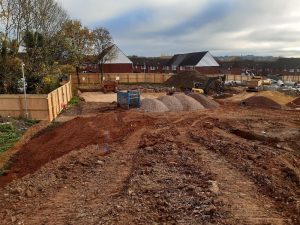The built environment currently contributes to approximately 25% of the UK’s carbon emissions according to research carried out by The UK Green Building Council (UKGBC). Although new builds are more energy efficient, 80% of buildings will have already been constructed by 2050, so it is a government priority to implement a strategy to decarbonise our existing architecture. The construction industry has been under increasing pressure to reduce its environmental impact and find innovative ways not only to design and build energy-efficient buildings but also to reduce carbon emissions throughout the construction process to support the UK’s Net Zero target by 2050.
The industry is exploring ways to strike a balance between quality and sustainability with Modern Methods of Construction (MMC). In this article, with assistance from Bond Bryan, Key Account Manager Natalie Palframan Explores the Benefits and Challenges of MMC.
What are Modern Methods of Construction?
MMC is defined as a process which focuses on offsite construction techniques, such as mass production and factory assembly, as alternatives to traditional building.’
MMC is not an entirely new concept. The idea of pre-fabricating elements of a building offsite first came into play after the Second World War following a need to rebuild and restore infrastructure at scale and pace.
Popularity for it ignited again in 2005 due to the housing crisis giving rise to a supply and demand issue for affordable and readily available homes. An entire residential home can be built in a factory and can be done much faster and more cost-effectively than building it onsite.
As in the case of the Ark Hotel built in China in 2011, all the materials were prefabricated and sections built to specification offsite meaning Chinese construction company Broad Group erected a 30-storey, Richter 9 earthquake-resistant hotel in just 15 days.
The Offsite Rule
Offsite construction is not a singular methodology but a host of techniques that are used to transport anything from small parts of a construction to an entire building from a factory environment to a construction site.
It is not a complete substitute for onsite construction. Even a prefabricated structure will require onsite assembly. The most common techniques are:
• 3D Volumetric Construction – or ‘modular’ construction. Units are built in a factory or warehouse before being transported to the site.
• Precast Panels – floor and wall units are made offsite and transported for onsite assembly to create a solid structure. Ideal for projects with repetitive production processes such as newly built homes.
• Precast Foundations – concrete walls or floors produced offsite using reusable moulds. Particularly useful when onsite weather conditions are poor.
• Twin Wall Technology – a technique where two pre-made walls are joined and reinforced before filling the gaps with concrete. This practice can also be used to adhere concrete walls and concrete floors together.
• Thin Joint Blockwork – or ‘thin joint masonry.’ A thinner depth of mortar can be used, 3mm versus 10mm, on the joint blockwork which can be conducted faster and more efficiently than onsite. In offsite conditions the mortar cures within 2 hours allowing for faster progression.
Why is MMC Beneficial?
Faster, Efficient, and High Quality
There are significant benefits to using MMC in public sector projects. The complex nature of construction projects can often lead to scope creep and delays, impacting budget and project timelines. Add to that the unpredictability of our UK weather and there is a raft of factors that can affect a project being delivered on time and within budget.
MMC projects can deliver time savings of between 10 to 50% on construction time. Units produced in a controlled environment offsite with the same materials allow for speed and consistency, as well as quality and precision.
This is particularly important for time-sensitive projects, such as a brand-new school that must be completed on time to welcome a cohort of students starting in the September term.
Safer with Reduced Risk
All MMC techniques improve both efficiency and productivity and because of this, the processes are pre-planned and formulaic, reducing risk.
There are additional safety benefits to working in a controlled offsite environment; reduced or no requirement for construction workers to work at height reducing the risk of falls and injury. No requirement for multi-disciplinary teams to be working at the same location so teams have more space to work safely. No live site construction vehicles reducing additional hazards. There is also the option to use robots or mechanical assistance to complete repetitive tasks a lot faster.
Cost Savings and Reduced Disruption
Using MMC processes reduces the time required onsite, meaning fewer materials to be managed and a reduced workforce. This high level of efficiency and productivity drives down costs.
The reduced requirement for onsite welfare facilities, parking and materials storage adds to the cost savings. In turn, the reduced construction traffic and general access traffic to create less disturbance for local residents. In areas where there are hospitals, schools, or densely populated communities this can be a huge benefit to keep community stakeholders on board.
Flexibility with Design
MMC methodologies often use renewable materials, such as timber, which offers designers much more flexibility in terms of the layout and the aesthetics of the build.
With methods such as precast panels, there is also a lot more flexibility for the designer in the production of windows, doors and furnishes.
However, it is the technology-led design within MMC projects that has improved the quality, flexibility, and innovation. Using Building Information Modelling (BIM) in software such as Revit is a fundamental tool in the MMC design process.
Sustainability
MMC techniques are efficient, reducing waste. The reduction in transportation of materials back and forth to a live site, coupled with the ultra-productive manufacturing methods that reduce energy use, all add up to a direct reduced impact on the environment and the overall sustainability and reduced carbon content of a project, both throughout the construction cycle and when the building is in use.
What are the challenges with MMC?
There are several challenges with using more modern methods of construction. The Built Environment Committee has recently published a letter to the Government following its inquiry into the future of MMC in housing. They have found there to be evidence of real barriers to MMC, such as risk aversion on the part of warranty providers, insurance companies and insufficient clarity for building regulations.
ord Moylan, chair of the Built Environment Committee, said, “In the context of an ageing skilled workforce and the need for greater building sustainability, MMC has shown some promise. We heard evidence that the Government couldn’t achieve its housebuilding targets without a sizeable contribution from the MMC sector.
“Our inquiry found that the Government has not set out clear objectives for the funding it provided the MMC sector. Homes England has not given any clear metrics as to how success is to be measured and over what timescale.”
Moreover, many of the materials and prefabricated systems used in MMC are imported, this has opened up criticisms of the process, as it could be seen to undermine UK manufacturing and impede the Levelling Up agenda.
Due to MMC practice largely taking place within a factory environment, this can have a negative impact on the social value of the project. It creates less opportunity for local employment and apprenticeship initiatives.
A fresh approach is required
The Built Environment Committee has recently published a letter to the Government following its inquiry into the future of MMC in housing. They have found there to be evidence of real barriers to MMC, such as risk aversion on the part of warranty providers, insurance companies and insufficient clarity for building regulations.
The Chair of the Built Environment Committee, said:
“In the context of an ageing skilled workforce and the need for greater building sustainability, MMC has shown some promise. We heard evidence that the Government couldn’t achieve its housebuilding targets without a sizeable contribution from the MMC sector.
“Our inquiry found that the Government has not set out clear objectives for the funding it provided the MMC sector. Homes England has not given any clear metrics as to how success is to be measured and over what timescale.
What does the future hold for MMC?
The Government supports modern methods of construction and sees MMC as an increasingly integral construction methodology of the future – that could offer highly efficient construction at scale. However, a much deeper understanding of how it works and to develop a clear strategy is needed.
So, will MMC be used across all public sectors? It is a common approach in education, with many newly built schools being manufactured using modular offsite solutions. Morgan Sindall has delivered three new schools in Essex using a net zero MMC approach. Colne Community School & College in Colchester, Clacton County High School in Clacton-on-Sea, and Sweyne Park School in Rayleigh will achieve a reduced environmental impact by attaining Net Zero Carbon whilst in operation.
In the housing sector, Burmor Construction has delivered several new homes across the East under the Procure Partnerships Framework. Since MMC has been incorporated into these schemes, they can be completed much faster than a traditional build and in view of the housing shortage MMC could be the preferred option for providing affordable housing to those most in need.
The Construction Playbook, developed by the Government and the Construction Leadership Council, looks to identify commonality across all sectors to scope out the elements and processes that are used to deliver a broad range of built assets. The Construction Playbook guide outlines the need to ‘harmonise, digitise and rationalise’ across projects and programmes. This demonstrates MMC will play a key role in delivering healthcare and blue light sector projects too.
Modern methods of construction could unlock the answer to the UK construction industry’s critical skills shortage, with a reduced requirement for so many skilled tradesmen onsite, as well as enhancing the environmental performance of buildings, pre and post-construction.
MMC is gaining popularity as it is more commonly acknowledged as a vital response to the demanding sustainability and net zero carbon targets the construction sector faces.
At Procure Partnerships we have a dedicated team of experienced professionals to support and advise with public sector procurement, with specialist expertise in Local Authority, Healthcare, Education, and Blue Light projects.
Helen Cliffe, Associate Architect RIBA on behalf of Bond Bryan: “The key to designing with MMC is to know the systems from the onset of the project so that any constraints can be understood and incorporated from the beginning and even treated as design features.
The use of MMC allows for higher quality control and more accurate design. The repetition and controlled environment process create efficiencies relating to cost and programmes. As the Architect, we will always try to re-inject some of these savings into higher-quality design. This could be by focusing on feature parts of the building where we can invest some of the savings, like entrances, cladding, and external amenities; without compromising on any other elements.
Our typical approach to ensuring MMC schemes retain design integrity and incorporate creativity would see us audit a scheme at the outset; considering our Client’s brief and aspirations, but also considering buildability, cost, programme and future flexibility.
Bond Bryan has a vast experience in MMC and the use of Design for Manufacture (DfMA) processes – and this experience and understanding will be crucial to ensuring schemes procured using MMC retain design integrity and incorporate creativity of the highest standards. Within the last five years alone, we have completed over 25 projects using MMC and or DfMA processes.
We believe that a modular approach (designed from inception) has the potential to generate substantial savings both in programme and construction costs. By fully understanding system constraints, you are able to design robust solutions and maximise creativity whilst working within known parameters”.
Click Here To Download a Procure Partnerships Framework User Guide
Twitter
Linkedin



